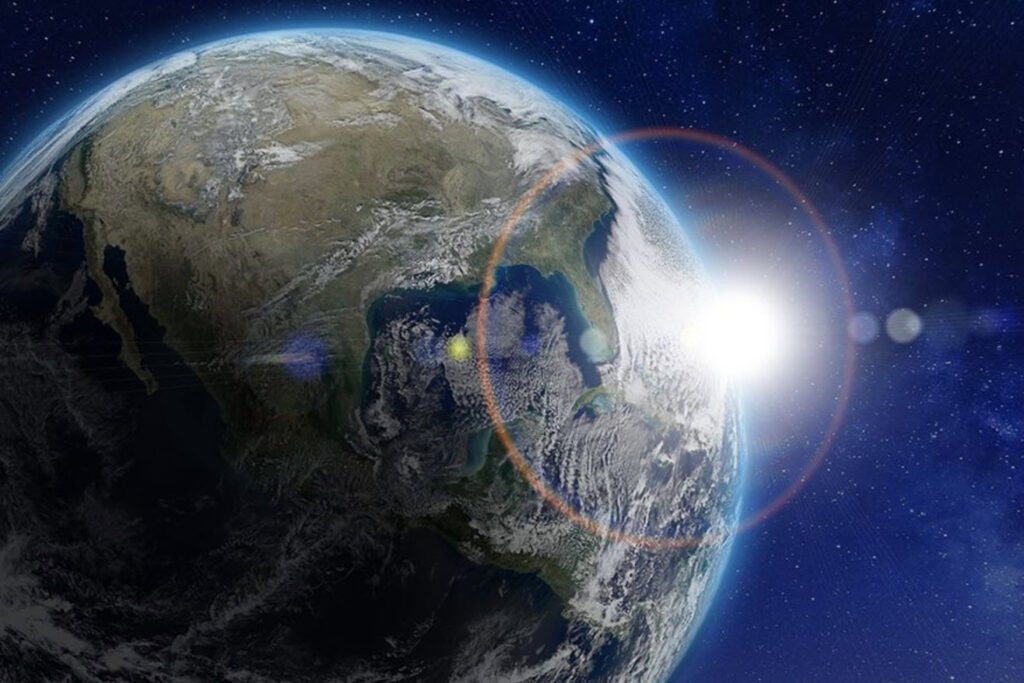
Earth, our home in the vast cosmos, is a planet full of wonders and complexities. From its rotation to tidal forces, geological formations to climatic anomalies, numerous questions arise that captivate the curious minds.
Let’s embark on a journey to explore some of the most intriguing questions related to our planet.
1. What makes Earth rotate?
The Earth’s rotation is a fundamental aspect of its existence. This rotation is a result of the planet’s initial angular momentum acquired during its formation from the primordial solar nebula. As the contracting cloud of gas and dust collapsed, the conservation of angular momentum caused it to spin faster, eventually forming a rotating celestial body — our Earth.
2. Anomalies in Day Lengths:
The peculiarities in the shortest day of the year, earliest sunset, and the latest sunrise are due to Earth’s axial tilt and its elliptical orbit. Earth’s axial tilt causes variations in the angle at which sunlight reaches different locations, leading to discrepancies in day length and temperature patterns.
3. Sun’s Altitude and Seasonal Lag:
The mismatch between the sun’s highest point and the warmest months occurs because Earth’s oceans and atmosphere act as heat reservoirs. It takes time for them to warm up, causing a delay in the peak temperatures relative to the sun’s highest point in the sky.
4. Asymmetry in Sunrise and Sunset:
The asymmetry in sunrise and sunset times is a result of Earth’s axial tilt and its elliptical orbit. Near the solstices, the change in the length of daylight is more pronounced, creating the observed asymmetry.
5. Daylight Equality Across Earth:
While all points on Earth experience the same duration of daylight during the equinoxes, the intensity of sunlight varies with latitude. This inequality in sunlight intensity contributes to the variation in climate and temperature across different regions.
6. Gravity on a Journey to Earth’s Center:
As one descends towards the Earth’s center, the sensation of gravity would decrease until reaching zero at the center. This is based on the concept of gravitational attraction being proportional to the mass and inversely proportional to the square of the distance between two objects.
7. Panoramic Views from Isthmus of Panama:
Hernando Cortés’ claimed vantage point is likely exaggerated. Due to the curvature of the Earth, a single vantage point cannot provide an unobstructed view of both the Atlantic and Pacific Oceans simultaneously.
8. Origin of Tidal Energy:
Tides result from gravitational interactions between Earth, the moon, and the sun. The energy comes from the Earth-moon-sun system’s orbital and rotational motions, converted into tidal energy through friction and tidal resonance.
9. Persistence of Sand Particle Sizes:
Sand particles reach a certain size due to the continual processes of weathering, erosion, and sedimentation. External factors, such as the availability of rocks and minerals, play a crucial role in maintaining the size of sand particles.
10. Hollow Earth Scenario:
If Earth were hollow, it would lack the structural integrity to withstand external forces. The planet’s gravitational forces would cause it to collapse inward, rendering such a scenario physically impossible.
11. Mass Redistribution and Earth’s Rotation:
While erosion and human activities do affect mass distribution, their impact on Earth’s rotation is negligible. The redistribution of mass does not significantly alter Earth’s rotational speed or day length.
12. Hypothetical Ocean Drainage:
A massive sea level drop due to a fault in Earth’s crust is highly unlikely. Even if such an event occurred, the consequences would be catastrophic for marine life, ecosystems, and the Earth’s geological stability.
13. Bay of Fundy’s Tidal Range:
The Bay of Fundy experiences the world’s largest tide ranges because of its unique funnel shape, resonance, and the position of the moon and sun. These factors amplify the tidal forces in this region.
14. Evolution of Challenger Deep and Mount Everest:
The deepening of ocean trenches and the changing height of mountains are ongoing geological processes. Challenger Deep and Mount Everest will continue to evolve, shaped by tectonic activities and natural geological forces.
15. Earth’s Ancient Heat and Radioactive Elements:
The early Earth was hotter due to the heat generated during accretion and the decay of radioactive elements. This intense heat influenced tectonic activity and the evolution of life, creating a vastly different environment compared to today.
16. Earth’s Magnetic Field and Heat:
The Earth’s magnetic field is generated by the movement of molten iron in its outer core. While heat influences the magnetic field, the mechanism sustaining it involves complex interactions in the Earth’s core that prevent its complete destruction.
In conclusion, Earth’s mysteries continue to captivate our imagination, and scientific inquiry gradually unveils the secrets of our dynamic and ever-evolving planet. Each question opens a door to a deeper understanding of the forces that shape our world.
You may also like:- Exploring the Enigmas of Science – Unraveling Celestial Mysteries and Physical Conundrums
- Semiconductor Related Terms – A Beginner’s Guide
- Major Trenches and Ridges Around the World
- [The Planets] Mercury to Neptune – Some Known Facts
- The Principal Causes of Pollution – A Comprehensive Overview
- Thermal Pollution – Causes, Effects, and Solutions
- What is Noise Pollution?
- Why Are Bacteria and Microbes Afraid of UV Light?
- Soil Pollution – Causes, Effects, and Solutions
- Did You Know Elephants Don’t Get Cancer?







